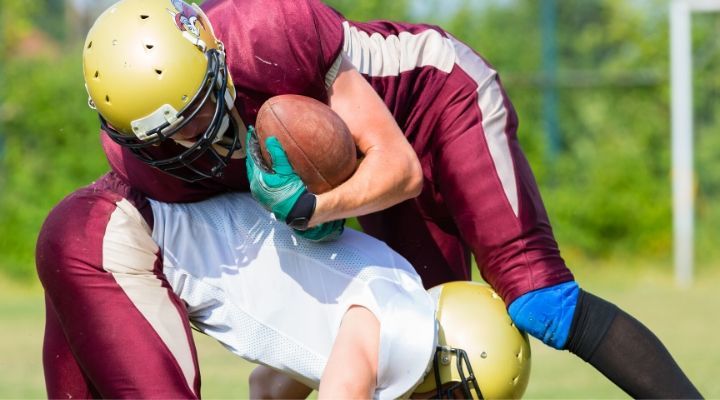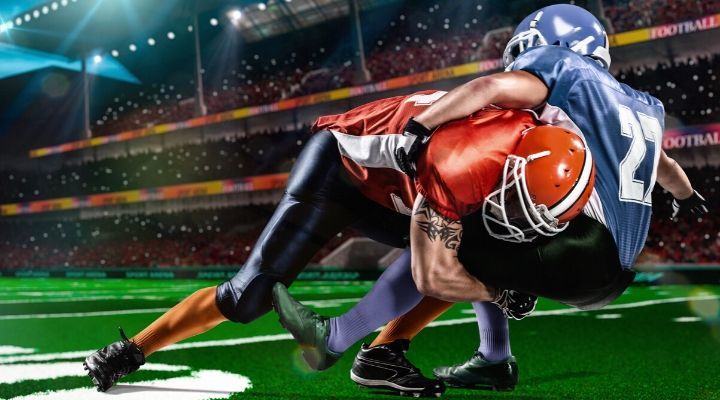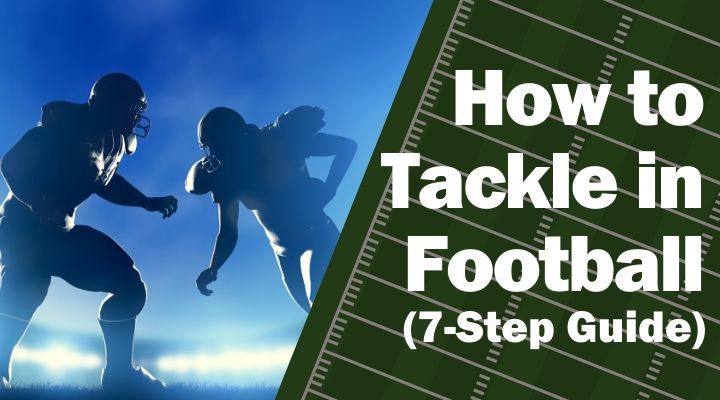There’s been a lot of talk about how to tackle in football properly over the last few years, as the NFL and NCAA football in America have taken hard stances to try to prevent devastating head injuries.
While all youth football players are taught the basics and fundamentals of tackling from a very young age, it's easy for them to lose focus as they grow older.
As has been seen in the upper levels of football recently, a lot of tacklers have focused on leading with their head and making huge hits on ball carriers, instead of properly wrapping up and tackling in a safe fashion.
Learning and consistently practicing the fundamentals of tackling is extremely important - both to ensure that the defender is able to make the tackle successfully and so both he and the ball carrier are able to avoid serious injury.
As we'll discuss later on in this article, not following these fundamentals can result in some truly tragic injuries such as continued concussions.
Following the proper tackling form will not only allow you to avoid injury - and to avoid causing injury to another - but it'll also ensure that you tackle the most effectively, accurately, and with the most power.
Practicing the fundamentals will also keep you from being faked out by a ball carrier and left in the dust as he runs downfield.
Let's take a step-by-step look at how to tackle in football properly.

How to Tackle in Football:
Step #1: Start With Your Feet
The first step to tackling properly is to keep your feet roughly shoulder-width apart. This will help you establish and maintain the proper form.
It not only will allow you to stay balanced with this wide base, but it'll help you stay lower to the ground, which is essential in making a good tackle.
In addition to having your feet spread apart shoulder-width, you want to also keep your knees bent slightly. This will get you in the proper pre-tackle position, ready to pounce.
Step #2: Focus on Your Shoulders
Setting up the proper tackling form prior to making contact is all about positioning yourself to give you the most power and control.
To do this, make sure you keep your shoulders down but back.
In this way, your chest should be pointing out, with your shoulders behind it.
With your chest pointed out and your knees bent slightly, the key is to form about a 45-degree angle from your head down your back and then out near your belly button.
At this point, you want to bring your hands up so they're ready to move. This is often called the "breakdown" position.
Step #3: Take Small, Quick Steps
As you're getting closer to making contact with a ball carrier, shuffle your feet in small, quick steps.
You'll do this as you're moving forward and from side to side.
This will prevent you from over-striding and potentially missing a tackle, and it'll also give you a spring-like motion from your feet when you're ready to pounce.
Step #4: Head Up
While you're doing Steps 1-3, make sure that you’re keeping your head back and up, and your eyes up as well.
Your neck will be back slightly, but not perfectly straight up and down.
This allows you to maintain good sight of the field and also keep your head and neck in a safe position as you make a tackle.
This is perhaps the biggest key to tackling properly.
If your head is down, it puts you in an extremely vulnerable position.
Not only does it make it easy for defenders to evade your tackle; it also puts you at extreme risk for very serious head and neck injuries.
Step #5: Spring Forward From the Breakdown
You get a majority of the power behind your tackles when you spring forward from the breakdown position. And that power comes from your hips.
By getting into the proper breakdown position, you'll be able to spring from the core of your body, which will give you enough power to stop the ball carrier's forward progress.
Just as you're about to tackle, plant one step and make sure your eyes and head are up before you spring forward.
Step #6: Explode Forward
After you establish that plant step, explode forward and up into the ball carrier, out of the breakdown position.
The key is to bring your arms up under the ball carrier's arms as you do this and then behind his back. This will help you knock the player to the ground, or at least force them to lose a lot of their momentum and/or balance.
This is called the "Rip Move" in tackling.
At the end of the rip move, your hands should be higher than your eyes are. Your hands should also basically hug the ball carrier, pulling him in toward your body in the process.
Step #7: Drive Forward
Your legs will close out the tackling work for you.
After you’ve completed the rip, you want to pump your legs with a lot of power, pushing the ball carrier backward and up.
If done properly, you'll take the ball carrier off of his feet, and put him on the ground.

Common Mistakes Players Make When Tackling
Learning the fundamentals of tackling is pretty simple, but there are a lot of steps a player must take in a very short amount of time.
Since football is such a fast game too, it can be easy for a player to miss one of these steps. Doing so can result in a missed tackle or even injury.
Let's take a look at the most common mistakes players make when they try to make a tackle in football.
Mistake #1: They Get Juked Out
Ball carriers aren't stationary targets. They’re moving in many different directions at a high rate of speed trying to avoid defenders as best as possible.
Their goal is to juke out defenders so they don't get tackled.
Defenders can often get faked out - thinking the ball carrier is going one way, only to have him make a move and go the other way.
The best way to avoid this is to watch the ball carrier's hips. They hold the key to knowing which direction the ball carrier is going to go.
If you watch his belt buckle, you can tell the direction he's planning to go.
Mistake #2: They Don't Wrap
The first half of the rip move is driving your hands under the ball carrier's and then bringing them up toward the sky.
A lot of tacklers do that part successfully, but they forget the second part - wrapping up.
Sometimes, the ball carrier will go to the ground after that initial contact, but many times, they remain on their feet, chugging along and trying to break free of your tackle.
If you don't wrap up your hands behind the ball carrier's back, it'll be much easier for him to break free.
Once you wrap your hands, keep them wrapped and continue driving through the ball carrier's body with your feet.
Mistake #3: They Get Their Hands Too High
It's not always possible to tackle a ball carrier straight on.
While that's the ideal alignment, a lot of times you'll be attempting your tackle from the side or back of the ball carrier.
When this happens, it's very easy to unintentionally touch or grab his facemask, which is a major penalty.
That's why it's so important to keep your hands down until you rip through the ball carrier.
If your hands are too high as you approach the tackle, your hands may make contact with the ball carrier's facemask, which will result in a 15-yard face masking penalty against you in most cases.
Mistake #4: They Leave Their Feet
One instinct that tacklers often have is to lunge forward toward the ball carrier. They think it gives them more power and force behind their tackles.
While lunging at a ball carrier could indeed result in a huge hit, it also often results in missed tackles, penalties and, worse, serious injury.
When you leave your feet when tackling, you’re giving up complete control of your body.
Wherever your body is aimed at the time you leave your feet is where it’ll end up. You won't be able to make any adjustments at all.
This means that a ball carrier can more easily evade your tackle. It also makes you much more vulnerable to commit a penalty such as making contact with your helmet and/or touching the ball carrier's facemask.
Most importantly though, it puts you and the ball carrier in an extremely vulnerable and dangerous position.
While you may watch professional and collegiate tacklers execute some truly huge hits by leaving their feet, they get lucky when they do so.
This is perhaps the gravest mistake you can make as a tackler. Simply put, avoid doing it at all costs.
Mistake #5: They Try to Strip the Ball
It can be so tempting to try to strip the ball loose from a ball carrier's hands when you’re making a tackle. After all, the ball is right there within your reach.
Causing a fumble is always a great thing, but don't concentrate on trying to do so until later in your tackle attempt.
If you focus on causing a fumble right from the get-go, you'll probably lose focus on making a proper tackle, which can lead to the ball carrier breaking free from your attempt.
You should only worry about trying to strip the ball as you have the ball carrier in your grasp and wrapped up.
You can also go for the strip if one of your teammates is the primary tackler and you're coming over to help.

Conclusion
Learning how to tackle in football is one of the most fundamental skills players will learn.
It's something that’s taught from almost Day 1, and it's something that all coaches should continue to reiterate and teach as players graduate to higher levels of the game.
While learning how to tackle properly is simple, it's also very easy to slip on one or more of the steps. This most often leads to a ball carrier breaking free from a tackle attempt or evading a defender altogether.
But the biggest reason why it's so important to learn how to tackle in football properly is so that you can avoid major injury to yourself and/or the ball carrier.
Football is a contact sport, and that's OK.
But it doesn't have to be dangerous.
Not following the fundamentals of how to tackle in football can easily lead to major injuries to the head and neck - which are some of the most devastating injuries in all of sports.

